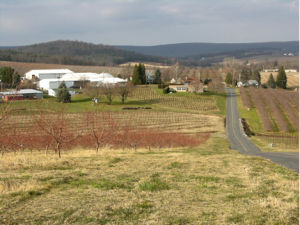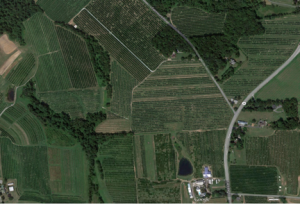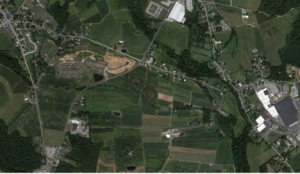America’s Orchard – South Mountain Fruit Belt

The South Mountain Fruit Belt is a significant component of the northern terminus of the Blue Ridge Mountains in south-central Pennsylvania. For over a century, a specialized fruit industry has flourished here, contributing to a rich agrarian heritage. Recognizing its economic and cultural importance, a network of partners has emerged to sustain the Fruit Belt’s landscape character and quality of life.
Topography, geology, and climate uniquely converge along the eastern slope of Pennsylvania’s South Mountain ridge; loamy soil and sloping hills ensure sufficient drainage, while the ridge is a buffer against harsh weather. This is an ideal fruit-growing condition; 20,000 acres of orchards annually produce more than 300 million pounds of apples and support a growing wine and agro-tourism industry.

Due to its proximity to Baltimore and Washington, D.C., Adams County is one of the fastest-growing Pennsylvania counties. Thus development pressures are threatening the Fruit Belt’s unique landscape character and heritage. Collaborative efforts are focused on preserving the working landscape, sustaining the Fruit Belt’s economic viability, and enriching the local sense of place for the region’s citizens. Much work is underway:
- The State Historic Preservation Office and Pennsylvania State University compiled a Historic Agriculture Context.
- Interpretative signage has been installed at key Fruit Belt locations.
- Partners are preparing documentation for National Register of Historic Places listing. The Adams County Office of Planning and Development is preparing a Fruit Belt Economic Impact Study.
- The South Mountain Partnership encourages stakeholders to protect, preserve, and enhance the local landscape.
Links

The South Mountain Partnership – South Mountain is Conservation Landscape, designated by the Pennsylvania Department of Conservation and Natural Resources (DCNR) and managed as a public-private partnership between DCNR and the Appalachian Trail Conservancy. The Partnership is a coalition of citizens, non-profit organizations, businesses, academic institutions, and local and state government agencies working to conserve the South Mountain landscape’s resources to enrich the quality of life and sense of place of its citizens and communities. View the 2009 strategic plan.
Historic Context by State Historic Preservation Office & Penn State
Thanks to Katie Hess, Jon Peterson and Bicky Redman for authoring this featured landscape report.


